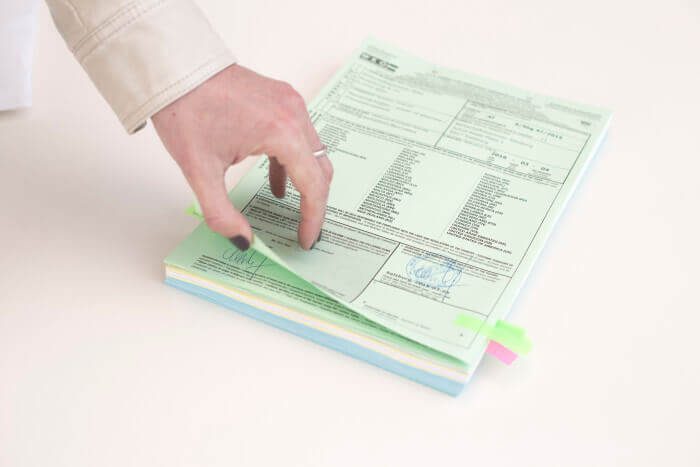Les documents de la FIATA
Nous sommes très heureux de vous présenter cette brochure révisée traitant des documents et formulaires FIATA; leur connaissance par chaque transitaire dans le monde entier, est d’autant plus importante que la promotion des conditions uniformes pour ces documents est un des objectifs majeurs de la FIATA. En effet, il y a plus de 40 ans que la profession a ressenti le besoin de disposer de ses propres documents.
C’est pour cette raison que la FIATA a crée ces documents standards et uniformes aux couleurs distinctes.
- 1955: le FIATA FCR – Forwarders Certificate of Receipt (vert)
- 1959: le FIATA FCT- Forwarders Certificate of Transport (jaune)
- 1970: le FBL- FIATA Negotiable Combined Transport Bill of Lading (bleu)
- 1975: le FWR – FIATA Warehouse Receipt (orange)
- 1992: le FBL adapté – Negotiable FIATA Multimodal Transport Bill of Lading (bleu), qui remplace le FIATA Negotiable Combined Transport Bill of Lading
Entre-temps, la plupart de nos pays membres ont introduit un, plusieurs ou la totalité de nos documents. Des millions d’exemplaires des FIATA FCR, FIATA FCT, FBL et FWR ont été émis. A ce jour, aucun cas de contestation juridique n’a été porté à notre connaissance, ce qui prouve la compétence et l’intégrité des transitaires qui émettent ces documents.
En outre, les FIATA FCR et FIATA FCT ont été reconnus par la Chambre de Commerce Internationale (CCI) en 1975 dans son document 470/251. Le FBL qui porte le logo CCI, démontre ainsi que ce formulaire est émis en conformité avec les “Règles UNCTAD/ICC sur les Documents de Transport Multimodal” de 1991.
Les documents de la FIATA ont une excellente réputation et sont reconnus comme des documents fiables et traditionnels. Ils ont largement contribué dans le passé à la facilitation des échanges internationaux et continueront à l’avenir d’être des instruments fiables au service du commerce mondial.
Dispositions générales
- Seules les organisations membres de la FIATA sont autorisées à procéder à l’impression et à la distribution de nos documents.
- Les organisations nationales de transitaires se chargent de l’impression des documents en français, anglais ou allemand, conformément et selon le texte et la configuration du spécimen autorisé. En dehors des trois langues officielles de la FIATA les documents peuvent être imprimés dans une autre langue nationale de l’organisation. Les organisations membres sont tenues d’indiquer sur les documents FIATA les abréviations du nom de leur pays, correspondant au code ONU, comme par exemple: AUTRICHE = AT, JAPON = JP, CANADA CA.
- Pour tous les documents, à l’exception des formulaires FIATA SDT et FFI, la numérotation en série est obligatore.
- Avant de procéder à l’édition des documents FIATA, les, organisations membres soumettront au Secrétariat de la FIATA les épreuves d’imprimerie pour approbation.
- Les documents FIATA ne peuvent être utilisés que par des entreprises membres de l’organisation nationale affiliée à la FIATA et ceci conformément aux dispositions contractuelles liant ces organisations à la FIATA. Pour le contrôle des documents émis, l’organisation membre tient un registre spécial dans lequel sont consignés les noms des entreprises membres à qui ces documents ont été remis, en indiquant les numéros en série.
- FIATA conserve le droit d’auteur des documents FIATA FCR, FIATA FCT, FWR, FBL et SDT. La reproduction des documents par des entreprises individuelles, sous quelque forme que ce soit, est strictement interdite.
FIATA FCR Forwarders Certificate of Receipt (Pour l’Expéditeur – Certificat de Prise en Charge)
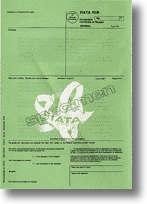 Le Forwarders Certificate of Receipt a été in troduit par la FIATA pour être utilisé par les transitaires internationaux, organisés dans le cadre de la FIATA. Le FIATA FCR permet au transitaire de remettre à l’expéditeur un document spécial attestant officiellement la prise en charge de la marchandise par ses soins. Le FIATA FCR peut être remis à l’expéditeur immédiatement après réception de la marchandise par le transitaire. En établissant un FIATA FCR, le transitaire certifie qu’il est en possession d’un envoi clairement identifié, avec comme instructions irrévocables d’expédier les marchandises au destinataire indiqué sur le document, ou de les tenir à sa disposition. Cet ordre ne peut être annulé que si l’original du FIATA FCR est retourné au transitaire qui l´a émis, et uniquement si le transitaire est encore en mesure d’en effectuer l’annulation ou la modification demandées.
Le Forwarders Certificate of Receipt a été in troduit par la FIATA pour être utilisé par les transitaires internationaux, organisés dans le cadre de la FIATA. Le FIATA FCR permet au transitaire de remettre à l’expéditeur un document spécial attestant officiellement la prise en charge de la marchandise par ses soins. Le FIATA FCR peut être remis à l’expéditeur immédiatement après réception de la marchandise par le transitaire. En établissant un FIATA FCR, le transitaire certifie qu’il est en possession d’un envoi clairement identifié, avec comme instructions irrévocables d’expédier les marchandises au destinataire indiqué sur le document, ou de les tenir à sa disposition. Cet ordre ne peut être annulé que si l’original du FIATA FCR est retourné au transitaire qui l´a émis, et uniquement si le transitaire est encore en mesure d’en effectuer l’annulation ou la modification demandées.
Le FIATA FCR sera avant tout utilisé, lorsque le fournisseur vend sa marchandise départ usine et a besoin de prouver qu’il a rempli ses obligations envers l’acheteur par la présentation d’un FIATA FCR. Dans le cas d’une lettre de crédit, le vendeur pourra dans ces conditions présenter un FIATA FCR, émis par le transitaire, en vue d’obtenir le paiement du prix de vente tenu à sa disposition par l’acheteur selon les termes de la lettre de crédit. Le vendeur ne peut plus disposer des marchandises remises au transitaire, quand le document FIATA FCR a été remis à l’acheteur.
Le FIATA FCR n’est pas négociable. Etant donné que la délivrance de la marchandise au destinataire ne dépend pas de la remise de ce document, un seul original est établi. Si des copies supplémentaires sont requises, il sera fait usage de formulaires surimprimés à cette fin avec les mots “Copie non négociable”.
En émettant le document FIATA FCR, le transitaire doit s’assurer que:
- l’envoi spécifié dans ce document a été réceptionné par lui-même ou par son agent (succursale, transitaire intermédiaire, etc.) et qu’il est seul en droit de disposer de l’envoi spécifié;
- les marchandises paraissent être en bon état apparent;
- les données reprises dans le document correspondent exactement aux instructions reçues;
- les conditions des documents de transport (B/L, etc.) ne sont pas en contradiction avec les obligations qu’il assume, conformément au document FIATA FCR.
Le document FIATA FCR comporte au verso les Conditions Générales du pays de l’organisation membre. Les seules entreprises autorisées à émettre ce document sont les entreprises de transitaires qui s’engagent à appliquer
ces Conditions Générales dans leurs transactions commerciales. Il est recommandé au transitaire de couvrir sa responsabilité en souscrivant une assurance «Responsabilité Civile» conforme aux conditions du FIATA FCR.
FIATA FCT Forwarders Certificate of Transport
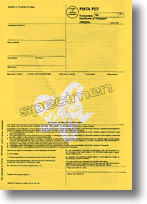 The Forwarders Certificate of Transport was introduced by FIATA for the use by inter-national freight forwarders within the FIATA Organizations. By issuing a FIATA FCT document to the con-signor, the freight forwarder assumes the obligation to deliver the goods at destination through the medium of an agent appointed by him. The FIATA A FCT can be handed over to the consignor immediately after the consignment has been handed over to the freight forwarder for shipment. By issuing the FIATA A FCT the freight forwarder certifies that he has assumed responsibility for dispatch and delivery of a specific consign-ment according to instructions he has re-ceived from the consignor as indicated in the document. The freight forwarder is responsible for the de-liveryof the consignment at destination through a delivery agent appointed by him to the holder of the document in accordance with the conditions stipulated on the reverse of the FIATA A FCT. The FIATA FCT has a “block” function. The freight forwarder is only responsible for the forwarding and delivery of the goods. The FIATA FCT, as distinguished from the FBL, is not a document subjecting the freight for-warder to a liability as carrier but his liability is governed by the applicable freight forwarding conditions. The FIATAA FCT will therefore be of importance in all cases where the transport has to be arranged for delivery to the consignee. The seller will be able to obtain payment of the sell-ing price from his bank against the FIATA FCT “cash against Documents”.The FIATA FCT is negotiable when made out “to Order” (see also ICC Doe. 470/251 Art. 24). The FIATA FCT is negotiable as the delivery of the consignment may only be effected against presentation of the original document, dulyendorsed.
The Forwarders Certificate of Transport was introduced by FIATA for the use by inter-national freight forwarders within the FIATA Organizations. By issuing a FIATA FCT document to the con-signor, the freight forwarder assumes the obligation to deliver the goods at destination through the medium of an agent appointed by him. The FIATA A FCT can be handed over to the consignor immediately after the consignment has been handed over to the freight forwarder for shipment. By issuing the FIATA A FCT the freight forwarder certifies that he has assumed responsibility for dispatch and delivery of a specific consign-ment according to instructions he has re-ceived from the consignor as indicated in the document. The freight forwarder is responsible for the de-liveryof the consignment at destination through a delivery agent appointed by him to the holder of the document in accordance with the conditions stipulated on the reverse of the FIATA A FCT. The FIATA FCT has a “block” function. The freight forwarder is only responsible for the forwarding and delivery of the goods. The FIATA FCT, as distinguished from the FBL, is not a document subjecting the freight for-warder to a liability as carrier but his liability is governed by the applicable freight forwarding conditions. The FIATAA FCT will therefore be of importance in all cases where the transport has to be arranged for delivery to the consignee. The seller will be able to obtain payment of the sell-ing price from his bank against the FIATA FCT “cash against Documents”.The FIATA FCT is negotiable when made out “to Order” (see also ICC Doe. 470/251 Art. 24). The FIATA FCT is negotiable as the delivery of the consignment may only be effected against presentation of the original document, dulyendorsed.
When issuing the FIATA FCT document the freight forwarder should ensure:
- that he or his agent (branch, intermediate freight forwarder) has taken over the con-signment specified therein and that the right of disposal of the goods vested solely in him;
- that the goods appear to be in apparent good order and condition;
- that the details on the document clearly correspond with the instructions he has received;
- that conditions of freight documents (B/L etc.) are not contrary to the obligations he has assumed according to the FIATA FCT document;
- that responsibility for the insurance of the consignment has been agreed;
- that it is clearly specified whether one or more originals have been issued.
It is recommended to dispatch the FIATA FCT documents by registered post only.The FIATA FCT bears the general national for-warding conditions of the issuing country on the reverse. The document may only be used by freight forwarders who adhere to these general conditions in their forwarding activi-ties. Greatest possible care must be taken in the preparation of these documents as the partic-ulars contained therein must reflect accurately the full details of the consignment, approved that a fee covering the preparation of the document by the issuing freight forwarder is therefore agreed and justified.
FBL – Negotiable FIATA Combined Transport Bill of Lading
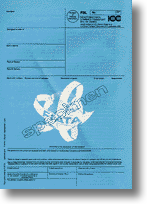 The FIATA Multimodal Transport Bill of Lading (FBL) is a carrier-type transport document set up by FIATA for the use by freight forwarders acting as multimodal transport operators (MTO).The FBL can also be issued as a marine bill of lading.The document is negotiable unless marked “non-negotiable”. It has been deemed by the International Chamber of Commerce (ICC) to be in conformity with the UNCTAD/ICC Rules for Multimodal Transport Documents pub-lished by ICC in its brochure No. 481. There-fore, the FBL bears the ICC logo alongside the symbol of the national #freight forwarders as-sociation. Furthermore, the Negoriable FIATA Multimodal Transport Bill of Lading is referred to in the “Guide for Documentary Credit Operations for the Uniform Customs and Practice for Docu-mentary Credits (UCP 500)” of ICC (ICC publi-cation No.515) as an acceptable freight for-warders transport document. A freight forwarder acting as MultiTransport Operator (MTO) or marine carrier is-suing a FBL is responsible for the performance of transport. The freight forwarder does not only assume responsible for delivery of the goods at destination, but also for all carriers and third parties engaged by him for the per-formance of the whole transport. By issuing a FBL the freight forwarder accepts a basic liability limit of 666.67 SDR per package .or unit, or 2 SDR per kilogramme of gross 22 weight of the goods lost or damaged, whichever is the higher (Art. 8.3 of the FBL conditions), or, if a multimodal transport does not indude carriage of goods by sea or inland waterways, a basic liability limit of 8.33 SDR per gross weight (Art. 8.5 of the FBL condi-tions). When loss of or damage to the goods can be attributed to a particular stage of trans-port in a multimodal transport operation, the freight forwarder’s liability is limitedaccording to mandatory national or international lawap-plicable to this stage of transport (Art. 8.6.a of the FBL conditions).
The FIATA Multimodal Transport Bill of Lading (FBL) is a carrier-type transport document set up by FIATA for the use by freight forwarders acting as multimodal transport operators (MTO).The FBL can also be issued as a marine bill of lading.The document is negotiable unless marked “non-negotiable”. It has been deemed by the International Chamber of Commerce (ICC) to be in conformity with the UNCTAD/ICC Rules for Multimodal Transport Documents pub-lished by ICC in its brochure No. 481. There-fore, the FBL bears the ICC logo alongside the symbol of the national #freight forwarders as-sociation. Furthermore, the Negoriable FIATA Multimodal Transport Bill of Lading is referred to in the “Guide for Documentary Credit Operations for the Uniform Customs and Practice for Docu-mentary Credits (UCP 500)” of ICC (ICC publi-cation No.515) as an acceptable freight for-warders transport document. A freight forwarder acting as MultiTransport Operator (MTO) or marine carrier is-suing a FBL is responsible for the performance of transport. The freight forwarder does not only assume responsible for delivery of the goods at destination, but also for all carriers and third parties engaged by him for the per-formance of the whole transport. By issuing a FBL the freight forwarder accepts a basic liability limit of 666.67 SDR per package .or unit, or 2 SDR per kilogramme of gross 22 weight of the goods lost or damaged, whichever is the higher (Art. 8.3 of the FBL conditions), or, if a multimodal transport does not indude carriage of goods by sea or inland waterways, a basic liability limit of 8.33 SDR per gross weight (Art. 8.5 of the FBL condi-tions). When loss of or damage to the goods can be attributed to a particular stage of trans-port in a multimodal transport operation, the freight forwarder’s liability is limitedaccording to mandatory national or international lawap-plicable to this stage of transport (Art. 8.6.a of the FBL conditions).
When issuing a FBL, the freight forwarder shouldensure:
- that he has taken over the goods specified therein and that the right of disposal of the goods is solely vested in him;
- that the goods appear to be in apparent good order and condition;
- that details on the document correspond with the instructions he has received;
- that responsibility for cargo insurance cover has been agreed upon with the consignor;
- that it is clearly specified how many original FBLs are issued.
Freight Forwarders issuing FBLs have to in-sure their liability in accordance with the FBL conditions.
FWR FIATA Warehouse Receipt
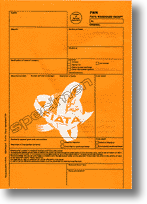 The freight forwarder often provides warehousing services. When doing so he has to issue a receipt for the merchandise. The FWR is a Warehouse Receipt for use in freight forwarders’ warehousing operations. It is a standard document mainly used at national level. The FWR is not a “récépissé-warrant”, which means a formal document recognized as warrant according to the applicable law. When a warehouse keeper is requested to issue a “récépissé-warrant”, the FWR cannot be used. If the issue of a legally recognised document of this kind is not required, the FWR can be issued in almost all cases. Its commercial character is practically the same as that of a “récépissé-warrant”. The FWR incorporates detailed provisions regarding the rights of the holders-by-endorsement of the document, the transfer of ownership, and the agreement that presentation of the warehouse receipt amounts to good delivery of the merchandise. For all practical purposes, such legal functions intended by the use of the FWR are recognized in most jurisdictions. The FWR is not negotiable, unless it is marked “negotiable”.It must be decided individually in each country which standard trading conditions are to be applied to the FIATA warehouse receipt. In countries where forwarders use standard trading conditions which include also provisions regarding the activity of warehouse keepers, such standard conditions are to be applied.
The freight forwarder often provides warehousing services. When doing so he has to issue a receipt for the merchandise. The FWR is a Warehouse Receipt for use in freight forwarders’ warehousing operations. It is a standard document mainly used at national level. The FWR is not a “récépissé-warrant”, which means a formal document recognized as warrant according to the applicable law. When a warehouse keeper is requested to issue a “récépissé-warrant”, the FWR cannot be used. If the issue of a legally recognised document of this kind is not required, the FWR can be issued in almost all cases. Its commercial character is practically the same as that of a “récépissé-warrant”. The FWR incorporates detailed provisions regarding the rights of the holders-by-endorsement of the document, the transfer of ownership, and the agreement that presentation of the warehouse receipt amounts to good delivery of the merchandise. For all practical purposes, such legal functions intended by the use of the FWR are recognized in most jurisdictions. The FWR is not negotiable, unless it is marked “negotiable”.It must be decided individually in each country which standard trading conditions are to be applied to the FIATA warehouse receipt. In countries where forwarders use standard trading conditions which include also provisions regarding the activity of warehouse keepers, such standard conditions are to be applied.
FIATA SDT Shippers Declaration for the Transport of Dangerous Goods
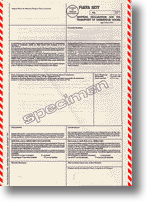 Apart from the documents examined that have been created by FIATA to promote uni-form rules in freight forwarders documents, FIATA also decided to place at the disposal of the freight forwarder a special form for the shipper’s declaration relating to the transport of dangerous goods: the FIATA SDT. If a Freight Forwarder deals with the transport of dangerous goods he needs detailed infor-mation with regard to the classification of the goods according to ADR for the transport by road, RID for the transport by rail and IMDG/IMO for the transport by sea. The clas-sification is shown on the reverse of the form. The Shippers Delcaration of the Transport of Dangerous Goods, FIATA SDT, allows the freight forwarder to identify the goods and to clarify the question of responsibility in case of accident or damage. Therefore it is important that the FIATA SDT is not filled-in by the freight forwarder. In each case the FIATA SDT must be completed and signed by the shipper and then handed over to the freight forwarder.
Apart from the documents examined that have been created by FIATA to promote uni-form rules in freight forwarders documents, FIATA also decided to place at the disposal of the freight forwarder a special form for the shipper’s declaration relating to the transport of dangerous goods: the FIATA SDT. If a Freight Forwarder deals with the transport of dangerous goods he needs detailed infor-mation with regard to the classification of the goods according to ADR for the transport by road, RID for the transport by rail and IMDG/IMO for the transport by sea. The clas-sification is shown on the reverse of the form. The Shippers Delcaration of the Transport of Dangerous Goods, FIATA SDT, allows the freight forwarder to identify the goods and to clarify the question of responsibility in case of accident or damage. Therefore it is important that the FIATA SDT is not filled-in by the freight forwarder. In each case the FIATA SDT must be completed and signed by the shipper and then handed over to the freight forwarder.
FIATA FFI – FIATA Forwarding Instructions
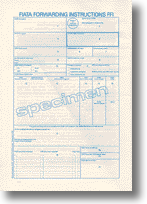 Freight Forwarders mostly design and print their own forwarding instructions forms which have to be filled in by their clients. However, the instruction forms of the various freight for-warders are non-uniform. FIATA therefore thought, that it would be ad-visable for Freight Forwarders to agree on a common layout and drafted the FIATA Model for Uniform Forwarding Instructions. The form is aligned to the UN layout key for trade docu-ments, which aims at providing an inter-national basis for the standardization of docu-ments used in international trade. The form is designed to be used in the alined series and to combine functions in sets of forms, of which integral parts serve various purposes in the procedures for cargo hand-ling. The member organisations of FIATA may adapt this instruction form to their national re-quirements, however, it is fundamental that such changes are made within the margin of the UN layout key. FIATA A recommends its national member orga-nizations to adopt and to introduce this in-struction form, as it is an important tool to improve professional standards and willserve to foster the corporate identity of our trade.
Freight Forwarders mostly design and print their own forwarding instructions forms which have to be filled in by their clients. However, the instruction forms of the various freight for-warders are non-uniform. FIATA therefore thought, that it would be ad-visable for Freight Forwarders to agree on a common layout and drafted the FIATA Model for Uniform Forwarding Instructions. The form is aligned to the UN layout key for trade docu-ments, which aims at providing an inter-national basis for the standardization of docu-ments used in international trade. The form is designed to be used in the alined series and to combine functions in sets of forms, of which integral parts serve various purposes in the procedures for cargo hand-ling. The member organisations of FIATA may adapt this instruction form to their national re-quirements, however, it is fundamental that such changes are made within the margin of the UN layout key. FIATA A recommends its national member orga-nizations to adopt and to introduce this in-struction form, as it is an important tool to improve professional standards and willserve to foster the corporate identity of our trade.
Quelle: FIATA, CH-8152 Glattbrugg, Switzerland
 Deutsch
Deutsch  English
English  Français
Français 

